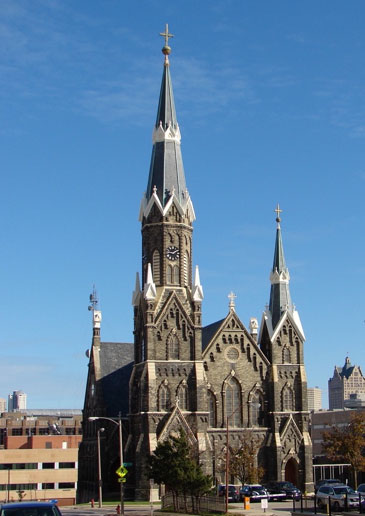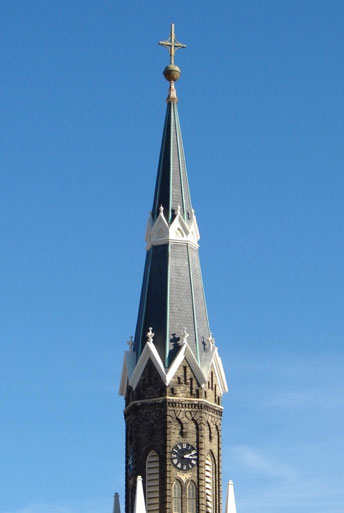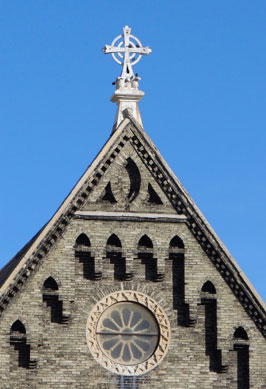29. Trinity Evangelical Lutheran, 1878
1026 North 9th Street (at West Highland Avenue)
Architect: Frederick Velguth
Trinity Lutheran was founded in 1847 by a group of German-speaking immigrants from Pomerania, the Baltic coastal region now divided between Germany and Poland. The present church is the congregation’s third house of worship. The first church was a small frame building constructed eight blocks away, at the corner of 4th and Wells Streets. The congregation built a larger church at 5th and Wells in 1850. John Pritzlaff, a member of the congregation and successful hardware merchant, donated the present church property at 9th and Highland Avenue in 1868. The congregation built a school on the site in the following year, while continuing to worship in the church at 5th and Wells. Construction of the present church began in 1878 and was completed in the spring of 1880.
The architect, Frederick Velguth (1838-1914), was born in the Prussian province of Saxony (now part of Germany) and came to Milwaukee in 1858. Trained as a carpenter, he initially carried on this trade, but in the 1870s he began to offer his services as an architect as well as a builder. Trinity Lutheran was one of Velguth’s first major architectural commissions, and remains his masterpiece. He later designed two other Lutheran churches in Milwaukee, both on the South Side: Christ Lutheran on Greenfield Avenue at 23rd Street (built in 1901) and Redeemer Lutheran on Rogers Street between 26th Street and Layton Boulevard. Redeemer Lutheran dates to 1906 and now serves a Spanish-language Protestant congregation.
The walls of Trinity Lutheran are Cream City brick on a limestone foundation, with stone trim for the buttress caps, stringcourses, keystones of the arches, and other ornamental features. The brickwork is the most elaborate of any Milwaukee religious building, with the exterior walls trimmed in lacework executed in masonry. In addition to the brick detailing around the doors and windows, there are corbeled arcades of different designs in the gables, at the eaves, and at the top of each stage of both towers. The northwest tower is topped by one of the city’s tallest steeples, reaching approximately 200 feet to the top of the cross.
Trinity was one of the largest Lutheran churches in the country when built, and continues to possess one of the largest worship spaces of any Lutheran church in Milwaukee. The nave is 55 feet wide, expanding to 89 feet in width at the transepts, and the vaulted ceiling reaches a height of 54 feet above the floor. The church originally had a seating capacity of about 1,200, which was reduced to about 1,000 in 1920 when a wood and glass partition was installed at the rear of the nave to create a large vestibule.
Just as the exterior displays the best of the bricklayer’s art, the interior furnishings exhibit the outstanding skills of Milwaukee’s nineteenth century carpenters and woodcarvers. The altar and pulpit are among the finest examples in any Milwaukee house of worship, as is the organ pipe case in the balcony. Erhard Brielmaier constructed the organ pipe case, during the period when he was specializing in church furnishings rather than working as an architect. The altar, pulpit, pews, and organ case all date to the time of the building’s construction. Later alterations have been limited primarily to the aforementioned partition at the rear of the nave, interior painting, and replacement of the original gaslights with electric fixtures.
Trinity Lutheran began offering services in English shortly after World War I, but also continued German-language services until 1959. As the neighborhood began to change after World War II, many of the churches in the area followed the migration of their members to the suburbs, often selling their inner-city buildings to black congregations. However, Trinity Lutheran opted to remain in the central city and became the first racially integrated Lutheran church in Milwaukee in 1949, welcoming a black family to membership in that year.
Sources:
100th Anniversary, 1847-1947: Trinity Lutheran Church, Milwaukee, Wisconsin. Trinity Lutheran Church, 1947.
“Corner Stone Laid,” Milwaukee Sentinel, July 8, 1878, page 8, column 1.
Flower, Frank A. History of Milwaukee, Wisconsin. Chicago: Western Historical Company, 1881. Facsimile reprint by the Milwaukee Genealogical Society, 1981.
“Frederick W. Velguth, Noted Architect, Dies,” Milwaukee Sentinel, April 10, 1914, page 4, column 3.
Historic Designation Study Report, Trinity Lutheran Church Complex. City of Milwaukee, Department of City Development, 2002.
Johnston, James M. “Trinity – A Mighty Fortress,” Milwaukee Sentinel, March 18, 1978, part 1, page 9, column 2.
Trinity Evangelical Lutheran Church: Founded 1847. Trinity Lutheran Church, 1981.
Wietczykowski, Mary Ellen. Trinity Evangelical Lutheran Church. Historic American Buildings Survey, 1968. HABS No. WI-273.



